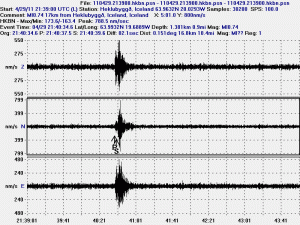There are interesting earthquakes about 20 km WSW of Laki. The locations of the earthquakes suggests strongly that they belong to Katla volcano fissure system. Last eruption in this area took place around the year 934. When the Eldgjá volcano canyon was formed. That eruption did destroy a older volcano canyon located in this same area (lava flows volcano ash did fill up that canyon far as I know).
The earthquakes that have been taking place in this area are small. The largest so far has the automatic size of ML1.2, but only ~4 earthquakes have been recorded so far. But what is most interesting about this earthquakes is the depth. The earthquakes that has the best automatic detection by the SIL system has the depth of 0.7 km. But that makes the depth of ~700 meters and that is a shallow earthquake. Given that this area has only fissures and no activate volcanoes. It is not unheard of in Iceland that a fissure eruption to start with no warning at all. Last time this did happen was in Gjálp eruption in the year 1996. Before that a dike intrusion into the bedrock did manage to get to the surface in Askja eruption in the year 1878, when a 25 km long volcano fissure did open up (small compared to Eldgjá eruption around the year 920).
I do not know what is going on in this area at the moment. As the activity so far has been too small to make any clear picture of it. But Katla volcano is a big volcano and it is not out of volcano league to make a new fissure eruption instead of the regular caldera eruptions under the glacier as Icelanders have gotten used to over the past 1000 years or so. Last time this did happen there are suggestions that there was a also a eruption at the same time in Katla volcano caldera. But that this has only been revealed during research over the past 50 years or so in this area.
I have also noted that there is a small increase in earthquakes inside Katla volcano caldera, not far from Austmannsbunga. But at this moment it is too early too know what it means for sure. There is no eruption is imminent in Katla volcano when this is written. Just too be clear on that fact.

